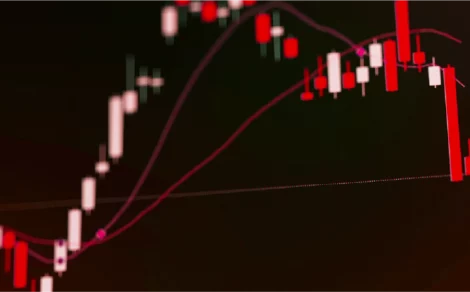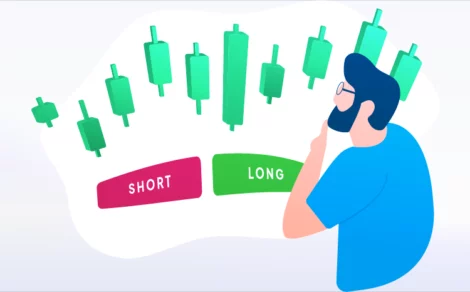A bear market occurs when stock prices fall by 20% or more over a sustained period.
Toruscope » Online Trading » Best Trading Strategies for a Bear Market in India
The stock market is constantly swinging between periods of growth and decline. While bull markets create wealth with soaring stock prices and investor confidence, bear markets bring fear, uncertainty, and widespread sell-offs. A bear market is officially defined as a 20% or more drop in major stock indices like the Nifty 50 and Sensex, often caused by economic slowdowns, geopolitical tensions, inflation, or financial crises.
For Indian investors, navigating a bear market can be challenging, but it doesn’t have to mean massive losses. While many investors panic and exit the market, experienced traders and strategists use bear markets as an opportunity. With the right approach, you can protect your investments, minimise risks, and even make profits during market downturns.
This blog will provide a comprehensive breakdown of the best bear market trading strategies tailored for Indian investors. You will learn how to identify market downturns, use stock market crash strategies, and explore real-world examples to understand each method in depth.
Understanding a Bear Market
A bear market is a prolonged period of declining stock prices, usually marked by a drop of 20% or more in a major stock index like the Nifty 50 or Sensex. It reflects negative investor sentiment, economic slowdowns, and shrinking corporate earnings. Unlike a short-term market dip, a bear market can last for months or even years, significantly impacting portfolios and trading strategies.
Characteristics of a Bear Market
A bear market is different from a temporary market dip. Here are the key characteristics that define a bear market:
- Prolonged Stock Price Declines – Major indices like Sensex and Nifty 50 fall significantly, often losing 20-50% of their value over several months.
- Negative Investor Sentiment – Fear and pessimism dominate the market, leading to heavy selling. Many retail investors often panic and exit, worsening the decline.
- Declining Corporate Earnings – Companies report lower profits due to reduced consumer spending, rising costs, and economic slowdowns.
- Reduced Trading Volumes – A lack of buying interest causes stocks to decline further, making recoveries slow.
- High Volatility – Markets witness sharp ups and downs, often driven by news, speculation, and global economic events.
- Sectoral Impact – Some sectors fall more sharply than others. High-growth industries like technology, real estate, and banking suffer the most, while defensive sectors like FMCG and pharmaceuticals tend to be more stable.
What Causes a Bear Market?
Bear markets are usually triggered by a combination of economic, financial, and geopolitical factors. Here are the major reasons that lead to bear markets in India:
-
High Inflation and Rising Interest Rates
When inflation rises, the Reserve Bank of India (RBI) increases interest rates to control price hikes. Higher interest rates make loans expensive, slowing down businesses and reducing consumer spending. This leads to lower corporate earnings, causing stock prices to drop.
In 2022, India saw inflation rise to 7.8%, prompting the RBI [VIE: RBI] to increase repo rates aggressively. This caused banking and real estate stocks to crash, leading to a market downturn.
-
Global Economic Slowdowns and Recessions
India’s economy is closely linked to global markets. When major economies like the US, China, or Europe slow down, it affects Indian exports, foreign investments, and overall growth.
The 2008 Global Financial Crisis, caused by the US housing bubble burst, led to a 60% drop in the Sensex as foreign investors pulled their money out of Indian markets.
-
Foreign Institutional Investor (FII) Outflows
Foreign investors play a crucial role in the Indian stock market. When they sell their holdings, it triggers a sharp decline in stock prices.
In early 2022, FIIs withdrew over ₹1.5 lakh crore from Indian markets due to global recession fears, leading to a 10% drop in Nifty 50 within months.
-
Geopolitical Uncertainty and Global Conflicts
Wars, trade tensions, and political instability create uncertainty, causing investors to pull back from riskier assets like stocks.
The Russia- Ukraine war in 2022 disrupted oil supplies, causing crude oil prices to surge. Since India imports most of its oil, rising prices increased inflation, leading to a bear market phase.
-
Corporate Scandals and Market Manipulations
Financial fraud and unethical business practices can shake investor confidence and cause stock prices to crash.
The Satyam Computers [NSE: SATYAMCOMP] Scam (2009) wiped out billions in investor wealth as the company admitted to falsifying its financial statements. In 2023, the Hindenburg Report on the Adani Group caused Adani stocks to crash by over 50%, triggering panic across Indian markets.
How to Identify a Bear Market?
A bear market doesn’t happen overnight. It is usually triggered by a combination of economic, political, and financial factors that cause investors to lose confidence in the market. The early signs of a bear market can often go unnoticed, but recognising these indicators can help traders and investors take precautionary steps before a full-blown downturn.
The key indicators of a bear market, which must be known for investors to choose an appropriate strategy to handle the same, are as follows:
-
Declining Stock Indices
The most obvious sign of a bear market is a prolonged decline in major stock indices like the Nifty 50, Sensex, and sectoral indices. When these indices fall by 20% or more from their recent highs and the downward trend persists, it signals a bear market.
During the 2008 global financial crisis, the BSE Sensex fell from nearly 21,000 in January 2008 to below 9,000 by October 2008, a drop of over 50% in just 10 months. Similarly, during the COVID-19 market crash in March 2020, the Nifty 50 fell from 12,000 to around 7,500 in just a few weeks, marking one of the fastest bear markets in Indian history.
-
Weak Market Sentiment and Fear
Investor sentiment plays a crucial role in the stock market. When fear and uncertainty dominate the market, trading volumes drop, new investments slow down, and panic selling increases. The India Volatility Index (VIX) is a key indicator of market fear. When it rises sharply, it indicates high volatility and nervousness among traders.
In early 2022, due to the Russia- Ukraine war, rising inflation, and fears of an economic slowdown, the India VIX spiked from 14 to 32, indicating extreme market fear. This was followed by a major decline in stocks across multiple sectors.
-
High Inflation and RBI Interest Rate Hikes
High inflation reduces consumer purchasing power, weakens corporate earnings, and impacts economic growth. To control inflation, the Reserve Bank of India (RBI) raises interest rates, making loans expensive for businesses and individuals. This leads to reduced corporate investments and lower stock prices.
Between 2022 and 2023, rising inflation forced the RBI to increase interest rates multiple times, making loans and EMIs costlier. As a result, stocks in real estate, banking, and automobile sectors fell significantly. Companies like DLF [NSE: DLF], HDFC Bank [NSE: HDFCBANK], and Maruti Suzuki [NSE: MARUTI] saw their stock prices decline due to reduced demand.
-
Continuous Decline in Corporate Earnings
One of the strongest signals of a bear market is falling corporate earnings. If major Indian companies report declining profits for multiple quarters, it reflects a weakening economy. Lower earnings lead to lower stock valuations, causing further sell-offs.
In 2019, the slowdown in auto sales led to lower profits for Maruti Suzuki [NSE: MARUTI], Tata Motors [NSE: TATAMOTORS], and Mahindra & Mahindra [NSE: M&M]. As a result, their stock prices fell sharply, dragging down the broader indices.
-
Foreign Institutional Investors (FII) Selling
Foreign Institutional Investors (FIIs) play a significant role in Indian stock markets. When FIIs withdraw large amounts of capital from Indian equities, the market experiences sharp corrections. This is usually a sign of a weakening economy or global uncertainties.
Between January and June 2022, FIIs pulled out over ₹2.5 lakh crore from Indian stock markets due to global economic concerns and the US Federal Reserve’s interest rate hikes. This led to a significant drop in Nifty 50 and Sensex, triggering a bear market phase.
-
Global Economic Slowdown
Since India is part of the global economy, events in major markets like the United States, Europe, and China impact Indian stock markets. A recession in the US or China can reduce demand for Indian exports, hurting companies in IT, pharmaceuticals, and manufacturing.
During the US recession in 2008, Indian IT companies like Infosys [NSE: INFY], TCS [NSE: TCS], and Wipro [NSE: WIPRO] saw their stock prices decline because their largest clients were US-based. Similarly, when China imposed strict lockdowns in 2022, the demand for Indian metal exports dropped, leading to a decline in stocks like Tata Steel [NSE: TATASTEEL] and Hindalco [NSE: HINDALCO].
-
Increase in Unemployment and Slow Economic Growth
When businesses struggle due to economic uncertainty, they slow down hiring or lay off employees. This reduces consumer spending, which in turn impacts company revenues, leading to a downward cycle.
During the COVID-19 pandemic in 2020, millions of jobs were lost in sectors like aviation, hospitality, and retail. Companies like IndiGo [NSE: INDIGO], Tata Motors [NSE: TATAMOTORS], and PVR Cinemas [NSE: PVRINOX] saw a major decline in their revenues, and their stock prices crashed accordingly.
Best Trading Strategies for the Indian Bear Market
Many investors panic during downturns, but seasoned traders know how to profit in a bear market by using strategies like short-selling, investing in defensive stocks, and buying put options.
-
Invest in Defensive Stocks
Investing in defensive stocks is one of the most reliable bear market trading strategies. These are the best stocks during a downturn because they belong to industries that provide essential goods and services, ensuring steady revenues even in economic crises.
Top Defensive Sectors in India
- Pharmaceuticals – Companies like Sun Pharma [NSE: SUNPHARMA], Cipla [NSE: CIPLA], and Dr. Reddy’s [NSE: DRREDDY] remain resilient as people always need medicines.
- FMCG (Fast-Moving Consumer Goods) – Stocks like ITC [NSE: ITC], HUL [NSE: HINDUNILVR], and Nestle India [NSE: NESTLEIND] perform well as daily essentials remain in demand.
- Utilities & Power – Tata Power [NSE: TATAPOWER], NTPC [NSE: NTPC], and Power Grid [NSE: POWERGRID] see stable demand for electricity.
- Insurance & Banking – SBI Life [NSE: SBILIFE] and HDFC Life [NSE: HDFCLIFE] continue collecting policy premiums even in slow markets.
During the 2020 COVID-19 crash, while airline and real estate stocks fell sharply, Nestle India [NSE: NESTLEIND] and Britannia [NSE: BRITANNIA] held strong due to rising demand for packaged foods and household essentials.
-
Short Selling in the Indian Stock Market
Short-selling allows traders to profit when stock prices fall. In India, you can short-sell in two ways:
- Intraday Short-Selling – Sell stocks first and buy them back later the same day at a lower price.
- Futures & Options (F&O) Trading – Short stocks using derivatives over a longer period.
If Reliance Industries is trading at ₹2,500 but is expected to fall to ₹2,400, a trader can:
- Borrow shares of Reliance [NSE: RELIANCE] and sell them at ₹2,500.
- Buy them back at ₹2,400.
- Earn a profit of ₹100 per share.
If the stock price rises instead of falling, losses can be unlimited in short-selling.
-
Buy Put Options to Hedge Risk
A put option is a contract that gives you the right to sell a stock at a fixed price, acting as insurance against losses. Put option:
- Helps protect a portfolio from a sharp downturn.
- Allows traders to profit from falling stock prices.
If you expect TCS [NSE: TCS] to drop from ₹3,500 to ₹3,200, you can:
- Buy a put option at ₹3,500.
- If TCS drops, you sell at ₹3,500 and avoid losses.
- If TCS rises, you lose only the small premium paid.
-
Focus on High-Dividend Stocks
Dividend-paying stocks generate passive income during bear markets, cushioning the impact of declining stock prices. The most preferred high-dividend stocks in India are:
- ITC [NSE: ITC] – Strong cash flow and high dividend yield.
- Coal India [NSE: COALINDIA] – Consistent government-backed dividends.
- HDFC Bank [[NSE: HDFCBANK] – Stable banking stock with regular payouts.
In 2022, while growth stocks declined, ITC’s dividend payouts provided steady income to investors.
-
Invest in Gold and Safe-Haven Assets
Gold has historically been a safe-haven investment during economic crises.
The best ways to invest in gold in India are:
- Sovereign Gold Bonds (SGBs) – RBI-issued bonds with interest + gold appreciation.
- Gold ETFs – Traded on NSE/BSE, offering easy liquidity.
- Physical Gold – Coins, bars, and jewellery (though storage risks exist).
During the 2008 recession, gold prices in India surged from ₹12,500 per 10 grams to over ₹30,000, making it a valuable hedge against stock market losses.
Conclusion
A bear market can be challenging, but with the right bear market trading strategies, Indian investors can protect their portfolios and even profit. Markets always recover—smart investors use downturns as opportunities to invest wisely and build long-term wealth.
Trade smarter with Torus Digital! Get expert insights, data-driven strategies, and market analysis—start making informed decisions today!
Frequently Asked Questions
Healthcare, FMCG, and utilities perform well due to stable demand.
They can short-sell, use put options, invest in inverse ETFs, and hold defensive stocks.
ITC, HUL, Nestle India, Sun Pharma, and Power Grid Corporation are the top choices.
Related Reads
What is Slippage in Trading? Meaning, Causes & Impact Explained
In trading, timing and precision often define success. However, even when a trader believes...
By: torus
- 7 mins
- 01.Jul.2025
- 4(1)
- 115
What is an Option Contract?
Imagine having the flexibility to buy or sell shares at a fixed price, no...
By: torus
- 7 mins
- 01.Jul.2025
- 0(0)
- 57
Types of Financial Instruments You Should Know Before Investing
Before investing funds in any market, it is essential to understand what financial instruments...
By: torus
- 7 mins
- 01.Jul.2025
- 0(0)
- 55
What are Contracts for Difference (CFD)?
Contracts for Difference, commonly known as CFDs, are financial instruments that allow traders to...
By: torus
- 9 mins
- 01.Jul.2025
- 0(0)
- 53
Difference between Short Position & Long Position
Understanding the concepts of short and long positions is essential for anyone interested in...
By: torus
- 8 mins
- 01.Jul.2025
- 0(0)
- 53
Essential Trading Terminologies You Need to Know
Trading in financial markets opens a world full of opportunities. For many first-time investors,...
By: torus
- 8 mins
- 01.Jul.2025
- 0(0)
- 59
Disclaimer: The content provided in this blog is for informational purposes only and does not constitute financial advice or recommendations. The content may be subject to change and revision. Readers are encouraged to conduct their own research and consult with a qualified financial advisor before making any investment decisions. Torus Digital and its affiliates takes no guarantees whatsoever as to its completeness, correctness or accuracy since these details may be acquired from third party and we will not be responsible for any direct or indirect losses or liabilities incurred from actions taken based on the information provided herein. For more details, please visit www.torusdigital.com.
MARC Technocrats IPO Opens: Key Details Investors Shouldn’t Miss
In December 2025, India’s IPO market continues to witness steady participation, especially in the...
By: torus
- 5 mins
- 12.Dec.2025
-
4(8)
-
282
KSH International IPO Opens: Key Details Investors Shouldn’t Miss
In late 2025, India’s IPO market continues to witness strong activity as companies across...
By: torus
- 6 mins
- 12.Dec.2025
-
4(8)
-
282
Neptune Logitek IPO Opens: Key Details Investors Shouldn’t Miss
India’s SME capital markets continue to attract companies from asset-intensive and service-driven sectors that...
By: torus
- 6 mins
- 12.Dec.2025
-
4(8)
-
282
Stocks to Buy Today: December 12, 2025
After a three-day selloff, Indian equities rebounded on Thursday, December 11, supported by buying...
By: torus
- 5 mins
- 12.Dec.2025
-
4.3(3)
-
282








